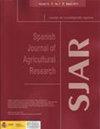补充姜黄可改善受 AFB1 挑战的鲤鱼的生长性能、生理反应和组织微结构
IF 0.8
4区 农林科学
Q3 AGRICULTURE, MULTIDISCIPLINARY
引用次数: 0
摘要
研究目的研究姜黄(TM)(姜黄)膳食补充剂对受到黄曲霉毒素 B1(AFB1)挑战的罗非鱼(Labeo rohita)的生长、血液学、生物化学参数和组织结构的影响。研究地区印度旁遮普省卢迪亚纳。材料与方法采用完全随机设计,在五个处理中使用了 225 条幼鱼,每个处理有三个重复。日粮分配如下:T1 表示阴性对照日粮,T2 包括 AF100,而 T3、T4 和 T5 则分别使用 AF25TM、AF50TM 和 AF100TM。主要结果结果表明,饲料中 AFB1 的用量与鱼的生长呈负相关,用量越大,鱼的生长越慢。血液学参数发生了显著变化,包括红细胞总数、白细胞总数、血红蛋白和包装细胞体积减少,生化参数也发生了变化,如总蛋白、白蛋白和球蛋白水平下降,葡萄糖水平和白蛋白/球蛋白比率上升。此外,与其他处理相比,T2 和 T5 的天门冬氨酸氨基转移酶、丙氨酸氨基转移酶、过氧化氢酶和超氧化物歧化酶水平升高。暴露于 AFB1 还会导致大脑、肾脏和肝脏组织的微观结构受损,尽管在 25 ppb AFB1 的条件下加入 TM 有恢复的迹象。研究亮点:观察到的变化与剂量有关,补充 TM 可增强对 AFB1 的抵抗力,对 T3 的改善最大。因此,与 50 ppb 和 100 ppb 的 AFB1 污染相比,含有 5 g TM kg-1 的日粮可降低 25 ppb 的 AFB1 污染。总之,在鱼饲料中补充 TM 有助于调节 AFB1,进而提高饲料产量。本文章由计算机程序翻译,如有差异,请以英文原文为准。
Growth performance, physiological response, and tissue microarchitecture of the carp Labeo rohita challenged with AFB1 are improved by supplementing with turmeric
Aim of study: To examine the impact of dietary supplementation with turmeric (TM) (Curcuma longa) on growth, haematological, biochemical parameters, and histoarchitecture in rohu (Labeo rohita) challenged with aflatoxin B1 (AFB1).
Area of study: Ludhiana, Punjab, India.
Material and methods: A completely randomized design involved the utilization of 225 fingerlings distributed across five treatments with three replicates each. Diets were allocated as follows: T1 denoted the negative control diet, T2 comprised AF100, while T3, T4, and T5 were formulated with AF25TM, AF50TM, and AF100TM, respectively.
Main results: The results indicated a negative correlation between AFB1 dosage in feed and fish growth, with higher doses resulting in decreased growth. Significant changes were observed in haematological parameters, including reductions in total erythrocyte count, total leukocyte count, haemoglobin, and packed cell volume, alongside alterations in biochemical parameters, such as decreases in total protein, albumin, and globulin levels, and an increase in glucose levels and albumin/globulin ratio. Additionally, elevated levels of aspartate aminotransferase, alanine aminotransferase, catalase and superoxide dismutase were noted in T2 and T5 compared to other treatments. AFB1 exposure also led to damage in the microarchitecture of the brain, kidney, and liver tissues, although inclusion of TM at 25 ppb AFB1 showed signs of recovery.
Research highlights: The changes observed were dose-dependent, and supplementation of TM showed increased resistance against AFB1 and the greatest improvement in T3. Therefore, a diet containing 5 g TM kg-1 would lower AFB1 contamination of 25 ppb compared to 50 and 100 ppb. In conclusion, supplementing TM in fish feeds can help regulating the AFB1, which in turn can improve sustenance-based output.
求助全文
通过发布文献求助,成功后即可免费获取论文全文。
去求助
来源期刊

Spanish Journal of Agricultural Research
农林科学-农业综合
CiteScore
2.00
自引率
0.00%
发文量
60
审稿时长
6 months
期刊介绍:
The Spanish Journal of Agricultural Research (SJAR) is a quarterly international journal that accepts research articles, reviews and short communications of content related to agriculture. Research articles and short communications must report original work not previously published in any language and not under consideration for publication elsewhere.
The main aim of SJAR is to publish papers that report research findings on the following topics: agricultural economics; agricultural engineering; agricultural environment and ecology; animal breeding, genetics and reproduction; animal health and welfare; animal production; plant breeding, genetics and genetic resources; plant physiology; plant production (field and horticultural crops); plant protection; soil science; and water management.
 求助内容:
求助内容: 应助结果提醒方式:
应助结果提醒方式:


